Report on Leadership & Management Concepts at Rolls-Royce - Unit 4
VerifiedAdded on 2023/04/10
|16
|3320
|359
Report
AI Summary
This report provides an in-depth analysis of leadership and management concepts, using Rolls-Royce as a case study. It distinguishes between the roles of managers and leaders, highlighting their significance in various organizational situations, such as dealing with financial losses and fostering innovation. The report also examines the management structure at Rolls-Royce, focusing on how recent restructuring efforts aim to improve operational efficiency and reduce costs. Key theories like Chaos Theory and Management by Objectives are discussed in relation to their potential to support organizational growth and sustainable performance. The report concludes with recommendations for effective leadership and management practices to enhance organizational performance and uphold the company's vision and mission. This document is available on Desklib, a platform offering AI-powered study tools and a wide range of academic resources for students.
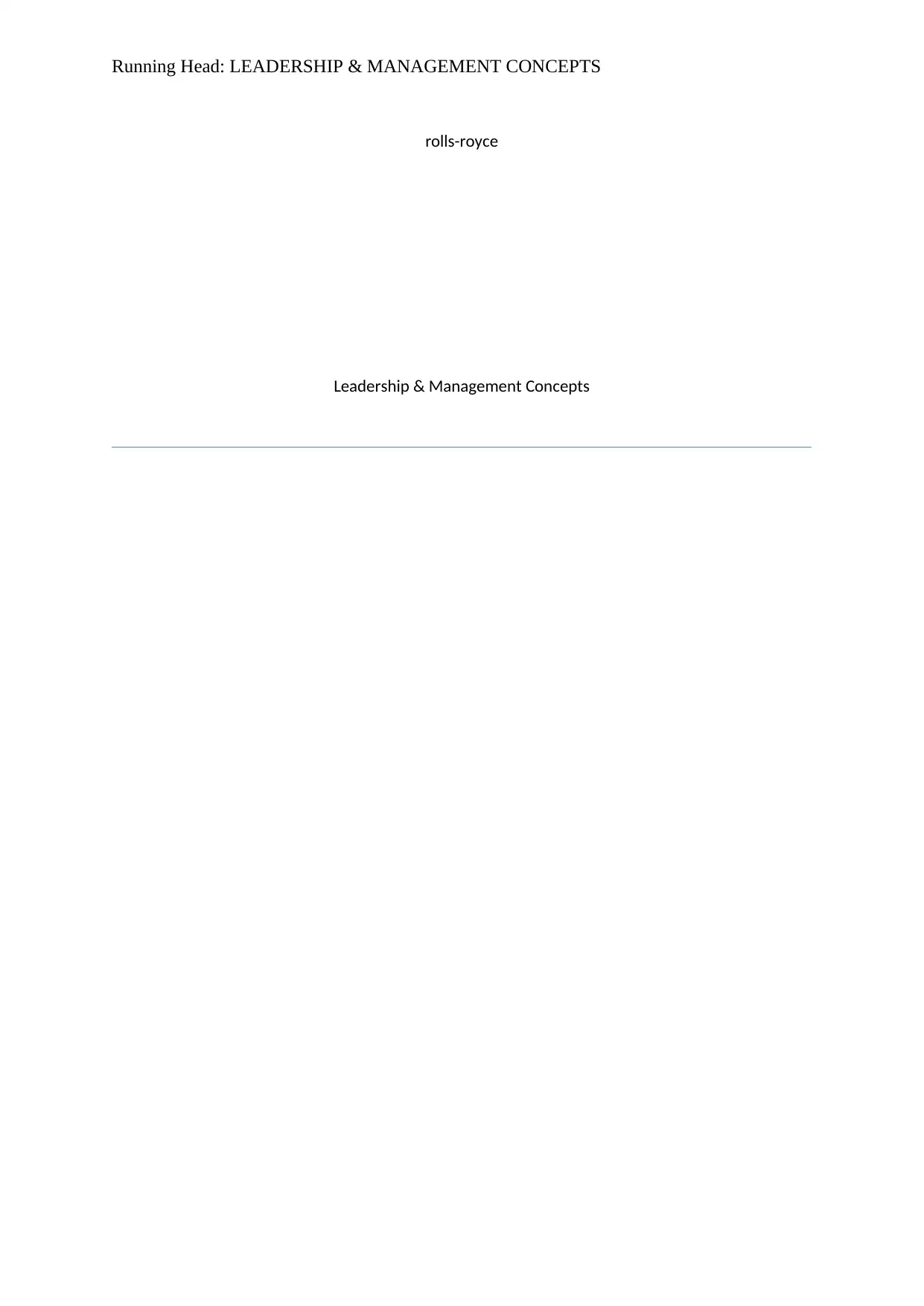
Running Head: LEADERSHIP & MANAGEMENT CONCEPTS
rolls-royce
Leadership & Management Concepts
rolls-royce
Leadership & Management Concepts
Paraphrase This Document
Need a fresh take? Get an instant paraphrase of this document with our AI Paraphraser

LEADERSHIP & MANAGEMENT CONCEPTS
Table of Contents
Introduction................................................................................................................................2
About Rolls-Royce.....................................................................................................................3
Management structure at Rolls-Royce.......................................................................................3
Roles played by Managers and Leaders.....................................................................................5
Roles of management and Leadership in different organizational situations............................8
Theories that support growth and sustainable performance of the organization.....................10
Recommendation......................................................................................................................12
Conclusion................................................................................................................................13
1 | P a g e
Table of Contents
Introduction................................................................................................................................2
About Rolls-Royce.....................................................................................................................3
Management structure at Rolls-Royce.......................................................................................3
Roles played by Managers and Leaders.....................................................................................5
Roles of management and Leadership in different organizational situations............................8
Theories that support growth and sustainable performance of the organization.....................10
Recommendation......................................................................................................................12
Conclusion................................................................................................................................13
1 | P a g e
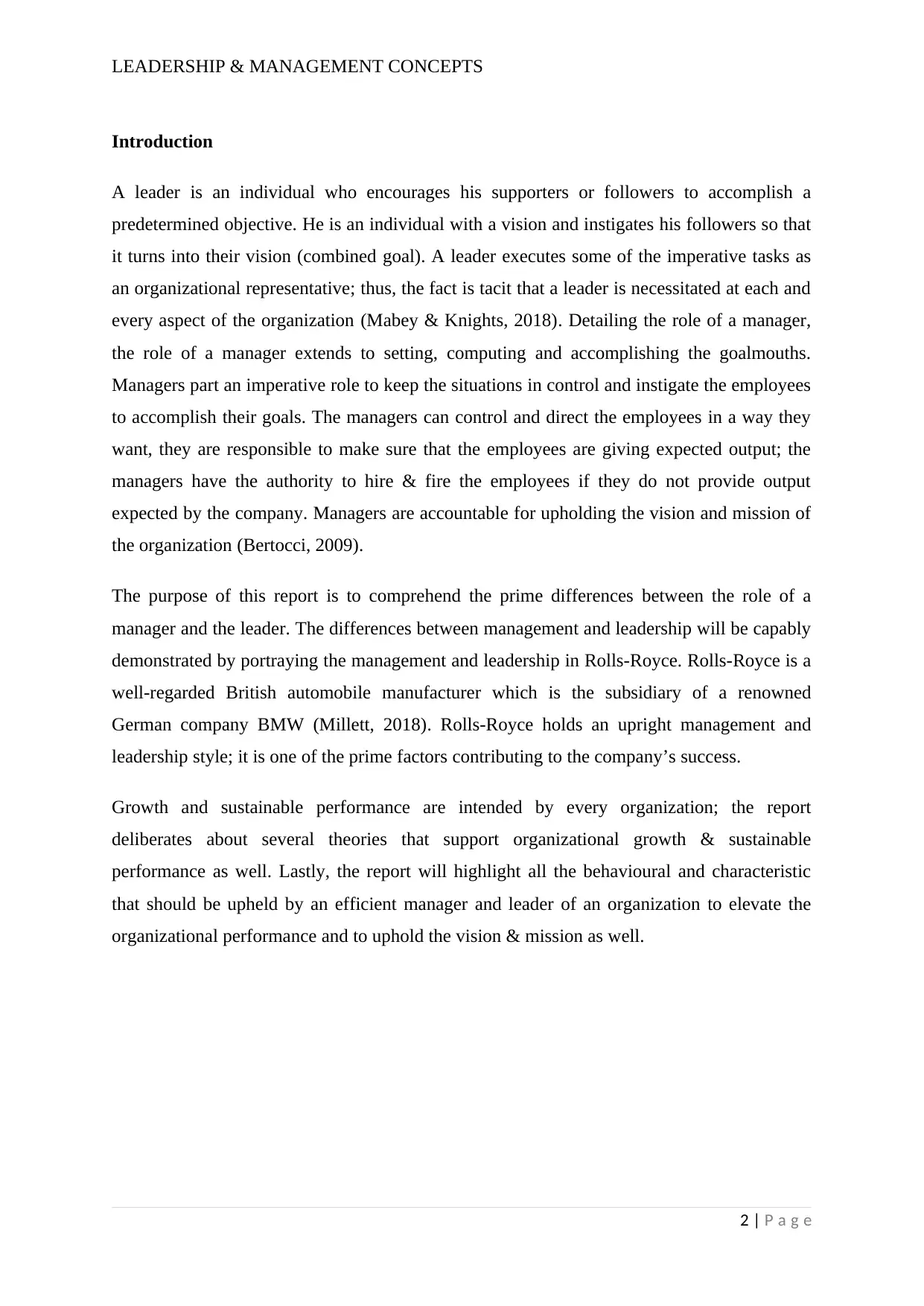
LEADERSHIP & MANAGEMENT CONCEPTS
Introduction
A leader is an individual who encourages his supporters or followers to accomplish a
predetermined objective. He is an individual with a vision and instigates his followers so that
it turns into their vision (combined goal). A leader executes some of the imperative tasks as
an organizational representative; thus, the fact is tacit that a leader is necessitated at each and
every aspect of the organization (Mabey & Knights, 2018). Detailing the role of a manager,
the role of a manager extends to setting, computing and accomplishing the goalmouths.
Managers part an imperative role to keep the situations in control and instigate the employees
to accomplish their goals. The managers can control and direct the employees in a way they
want, they are responsible to make sure that the employees are giving expected output; the
managers have the authority to hire & fire the employees if they do not provide output
expected by the company. Managers are accountable for upholding the vision and mission of
the organization (Bertocci, 2009).
The purpose of this report is to comprehend the prime differences between the role of a
manager and the leader. The differences between management and leadership will be capably
demonstrated by portraying the management and leadership in Rolls-Royce. Rolls-Royce is a
well-regarded British automobile manufacturer which is the subsidiary of a renowned
German company BMW (Millett, 2018). Rolls-Royce holds an upright management and
leadership style; it is one of the prime factors contributing to the company’s success.
Growth and sustainable performance are intended by every organization; the report
deliberates about several theories that support organizational growth & sustainable
performance as well. Lastly, the report will highlight all the behavioural and characteristic
that should be upheld by an efficient manager and leader of an organization to elevate the
organizational performance and to uphold the vision & mission as well.
2 | P a g e
Introduction
A leader is an individual who encourages his supporters or followers to accomplish a
predetermined objective. He is an individual with a vision and instigates his followers so that
it turns into their vision (combined goal). A leader executes some of the imperative tasks as
an organizational representative; thus, the fact is tacit that a leader is necessitated at each and
every aspect of the organization (Mabey & Knights, 2018). Detailing the role of a manager,
the role of a manager extends to setting, computing and accomplishing the goalmouths.
Managers part an imperative role to keep the situations in control and instigate the employees
to accomplish their goals. The managers can control and direct the employees in a way they
want, they are responsible to make sure that the employees are giving expected output; the
managers have the authority to hire & fire the employees if they do not provide output
expected by the company. Managers are accountable for upholding the vision and mission of
the organization (Bertocci, 2009).
The purpose of this report is to comprehend the prime differences between the role of a
manager and the leader. The differences between management and leadership will be capably
demonstrated by portraying the management and leadership in Rolls-Royce. Rolls-Royce is a
well-regarded British automobile manufacturer which is the subsidiary of a renowned
German company BMW (Millett, 2018). Rolls-Royce holds an upright management and
leadership style; it is one of the prime factors contributing to the company’s success.
Growth and sustainable performance are intended by every organization; the report
deliberates about several theories that support organizational growth & sustainable
performance as well. Lastly, the report will highlight all the behavioural and characteristic
that should be upheld by an efficient manager and leader of an organization to elevate the
organizational performance and to uphold the vision & mission as well.
2 | P a g e
⊘ This is a preview!⊘
Do you want full access?
Subscribe today to unlock all pages.

Trusted by 1+ million students worldwide

LEADERSHIP & MANAGEMENT CONCEPTS
About Rolls-Royce
Rolls-Royce is a prestigious organization and it has endured itself in the prominent names in
engineering throughout the globe. Rolls-Royce was established by Henry Royce in the year
1884; initially, the company was established as a mechanical and electrical business. The
company manufactured its first car in the year 1904; afterwards, in May Henry met Charles
Rolls who owned a company selling cars in London. Later, a covenant was produced that
different ranges of cars would be manufactured by Royce Limited and it would be entirely
vended by CS Rolls & Co, they were about to change the name as Rolls-Royce. The car
making business was handled by Henry, as his main interest were cars, whereas Charles’s
interests encompassed building aircraft engines as well (Rolls-Royce, 2019).
At the time of World War First, luxury cars were only afforded by a few people in the
society, so the company had to concentrate on aircraft engine manufacturing as well. And by
the World War Second, Rolls-Royce established a prospering business of aircraft engine
manufacturing. Soon after the war Rolls-Royce propagated & expanded into diverse market
segments, elevating the value of brand name. The company’s vision is to unceasingly
innovate to discover & deliver the preeminent solutions to the target markets (Rolls-Royce,
2019). The company thrives to discover the opportunities and challenges faced by the
customers. Rolls-Royce operates in Europe, Asia, North America and evolving its existence
in the Middle East. Currently, the company operates in Defence Aerospace, Power Systems,
Marine, Civil Aerospace and Nuclear Segment. Presently, Rolls-Royce has a strong customer
base which is extended over 120 countries, encompassing more than 350 airlines, 4000
marine clienteles, 70 navies & greater than 5000 nuclear & power clienteles (Parry, et al.,
2012).
Management structure at Rolls-Royce
Recently, Rolls-Royce detached a level of senior management as part of a rearrangement
programme. The company decided to restructure the management to enhance the harmony
and improve the operational excellence which would primarily aid in reducing costs and
elevate revenues (Foxwell, 2015).
The company primarily functions in five businesses with the presidents of Civil Aerospace,
Defence Aerospace, Nuclear, Marine & Power Systems in which chief executive has to be
3 | P a g e
About Rolls-Royce
Rolls-Royce is a prestigious organization and it has endured itself in the prominent names in
engineering throughout the globe. Rolls-Royce was established by Henry Royce in the year
1884; initially, the company was established as a mechanical and electrical business. The
company manufactured its first car in the year 1904; afterwards, in May Henry met Charles
Rolls who owned a company selling cars in London. Later, a covenant was produced that
different ranges of cars would be manufactured by Royce Limited and it would be entirely
vended by CS Rolls & Co, they were about to change the name as Rolls-Royce. The car
making business was handled by Henry, as his main interest were cars, whereas Charles’s
interests encompassed building aircraft engines as well (Rolls-Royce, 2019).
At the time of World War First, luxury cars were only afforded by a few people in the
society, so the company had to concentrate on aircraft engine manufacturing as well. And by
the World War Second, Rolls-Royce established a prospering business of aircraft engine
manufacturing. Soon after the war Rolls-Royce propagated & expanded into diverse market
segments, elevating the value of brand name. The company’s vision is to unceasingly
innovate to discover & deliver the preeminent solutions to the target markets (Rolls-Royce,
2019). The company thrives to discover the opportunities and challenges faced by the
customers. Rolls-Royce operates in Europe, Asia, North America and evolving its existence
in the Middle East. Currently, the company operates in Defence Aerospace, Power Systems,
Marine, Civil Aerospace and Nuclear Segment. Presently, Rolls-Royce has a strong customer
base which is extended over 120 countries, encompassing more than 350 airlines, 4000
marine clienteles, 70 navies & greater than 5000 nuclear & power clienteles (Parry, et al.,
2012).
Management structure at Rolls-Royce
Recently, Rolls-Royce detached a level of senior management as part of a rearrangement
programme. The company decided to restructure the management to enhance the harmony
and improve the operational excellence which would primarily aid in reducing costs and
elevate revenues (Foxwell, 2015).
The company primarily functions in five businesses with the presidents of Civil Aerospace,
Defence Aerospace, Nuclear, Marine & Power Systems in which chief executive has to be
3 | P a g e
Paraphrase This Document
Need a fresh take? Get an instant paraphrase of this document with our AI Paraphraser

LEADERSHIP & MANAGEMENT CONCEPTS
reported in a straight line. The management structure upheld at Rolls-Royce is focused to
illuminate the administrative culpabilities and strengthen the leadership on the enactment of
the operation and empower the organization to enhance its top-notch engineering
competencies. The management structured has been designed in a way that the business
would be more resilient and generate the incremental gross cost reserves of £150-200 million
per annum (Rolls-Royce, 2019).
4 | P a g e
reported in a straight line. The management structure upheld at Rolls-Royce is focused to
illuminate the administrative culpabilities and strengthen the leadership on the enactment of
the operation and empower the organization to enhance its top-notch engineering
competencies. The management structured has been designed in a way that the business
would be more resilient and generate the incremental gross cost reserves of £150-200 million
per annum (Rolls-Royce, 2019).
4 | P a g e
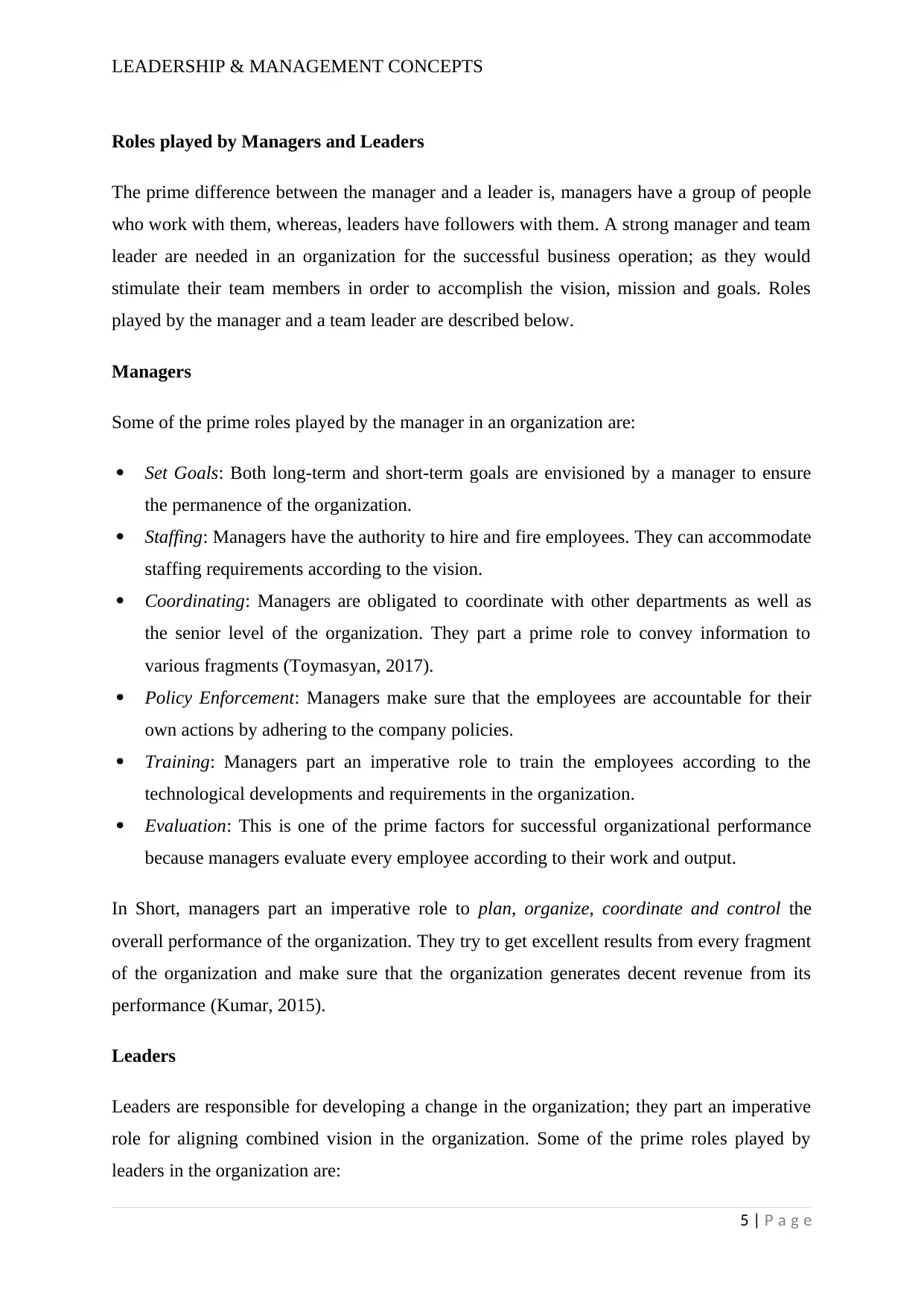
LEADERSHIP & MANAGEMENT CONCEPTS
Roles played by Managers and Leaders
The prime difference between the manager and a leader is, managers have a group of people
who work with them, whereas, leaders have followers with them. A strong manager and team
leader are needed in an organization for the successful business operation; as they would
stimulate their team members in order to accomplish the vision, mission and goals. Roles
played by the manager and a team leader are described below.
Managers
Some of the prime roles played by the manager in an organization are:
Set Goals: Both long-term and short-term goals are envisioned by a manager to ensure
the permanence of the organization.
Staffing: Managers have the authority to hire and fire employees. They can accommodate
staffing requirements according to the vision.
Coordinating: Managers are obligated to coordinate with other departments as well as
the senior level of the organization. They part a prime role to convey information to
various fragments (Toymasyan, 2017).
Policy Enforcement: Managers make sure that the employees are accountable for their
own actions by adhering to the company policies.
Training: Managers part an imperative role to train the employees according to the
technological developments and requirements in the organization.
Evaluation: This is one of the prime factors for successful organizational performance
because managers evaluate every employee according to their work and output.
In Short, managers part an imperative role to plan, organize, coordinate and control the
overall performance of the organization. They try to get excellent results from every fragment
of the organization and make sure that the organization generates decent revenue from its
performance (Kumar, 2015).
Leaders
Leaders are responsible for developing a change in the organization; they part an imperative
role for aligning combined vision in the organization. Some of the prime roles played by
leaders in the organization are:
5 | P a g e
Roles played by Managers and Leaders
The prime difference between the manager and a leader is, managers have a group of people
who work with them, whereas, leaders have followers with them. A strong manager and team
leader are needed in an organization for the successful business operation; as they would
stimulate their team members in order to accomplish the vision, mission and goals. Roles
played by the manager and a team leader are described below.
Managers
Some of the prime roles played by the manager in an organization are:
Set Goals: Both long-term and short-term goals are envisioned by a manager to ensure
the permanence of the organization.
Staffing: Managers have the authority to hire and fire employees. They can accommodate
staffing requirements according to the vision.
Coordinating: Managers are obligated to coordinate with other departments as well as
the senior level of the organization. They part a prime role to convey information to
various fragments (Toymasyan, 2017).
Policy Enforcement: Managers make sure that the employees are accountable for their
own actions by adhering to the company policies.
Training: Managers part an imperative role to train the employees according to the
technological developments and requirements in the organization.
Evaluation: This is one of the prime factors for successful organizational performance
because managers evaluate every employee according to their work and output.
In Short, managers part an imperative role to plan, organize, coordinate and control the
overall performance of the organization. They try to get excellent results from every fragment
of the organization and make sure that the organization generates decent revenue from its
performance (Kumar, 2015).
Leaders
Leaders are responsible for developing a change in the organization; they part an imperative
role for aligning combined vision in the organization. Some of the prime roles played by
leaders in the organization are:
5 | P a g e
⊘ This is a preview!⊘
Do you want full access?
Subscribe today to unlock all pages.

Trusted by 1+ million students worldwide
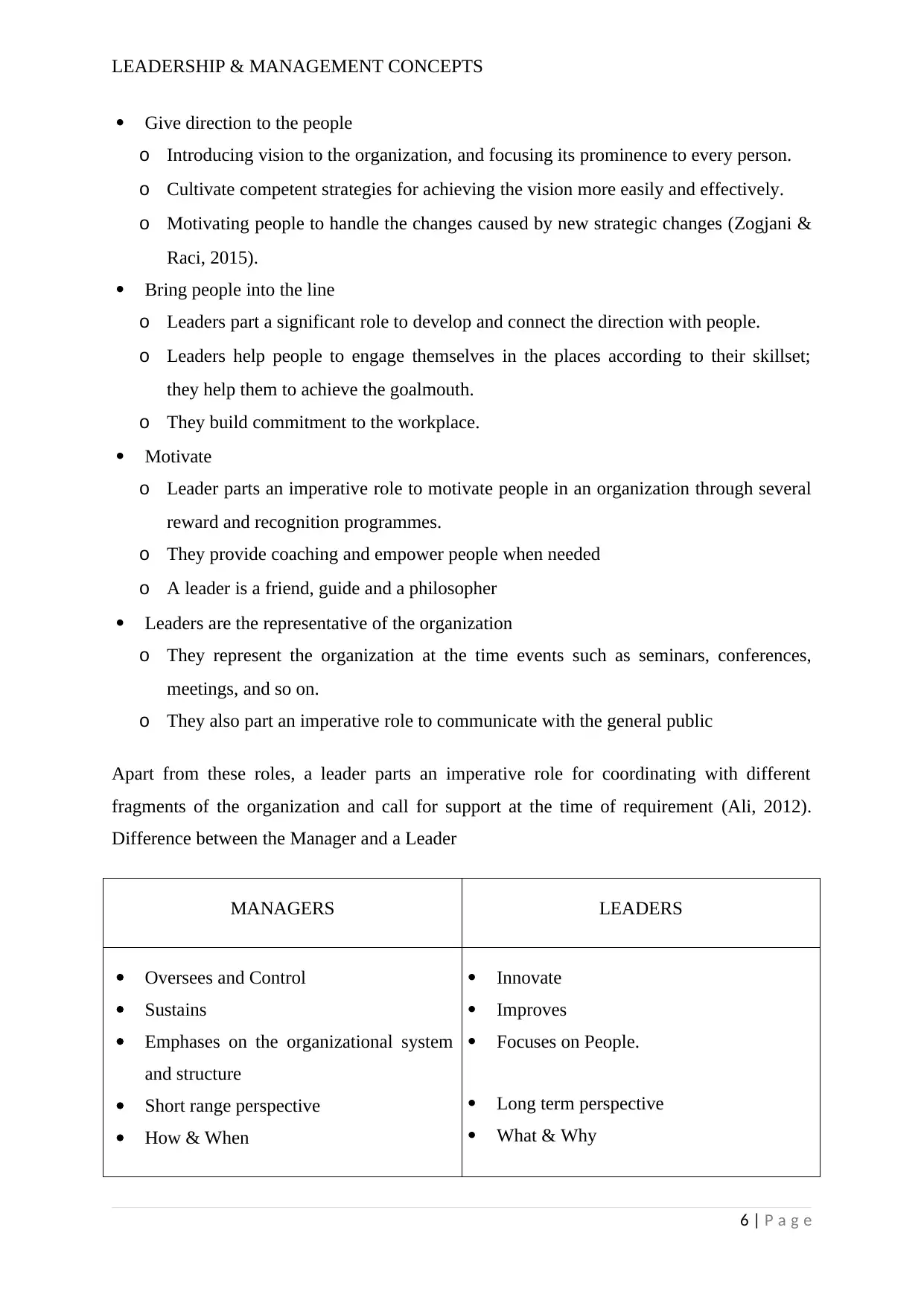
LEADERSHIP & MANAGEMENT CONCEPTS
Give direction to the people
o Introducing vision to the organization, and focusing its prominence to every person.
o Cultivate competent strategies for achieving the vision more easily and effectively.
o Motivating people to handle the changes caused by new strategic changes (Zogjani &
Raci, 2015).
Bring people into the line
o Leaders part a significant role to develop and connect the direction with people.
o Leaders help people to engage themselves in the places according to their skillset;
they help them to achieve the goalmouth.
o They build commitment to the workplace.
Motivate
o Leader parts an imperative role to motivate people in an organization through several
reward and recognition programmes.
o They provide coaching and empower people when needed
o A leader is a friend, guide and a philosopher
Leaders are the representative of the organization
o They represent the organization at the time events such as seminars, conferences,
meetings, and so on.
o They also part an imperative role to communicate with the general public
Apart from these roles, a leader parts an imperative role for coordinating with different
fragments of the organization and call for support at the time of requirement (Ali, 2012).
Difference between the Manager and a Leader
MANAGERS LEADERS
Oversees and Control
Sustains
Emphases on the organizational system
and structure
Short range perspective
How & When
Innovate
Improves
Focuses on People.
Long term perspective
What & Why
6 | P a g e
Give direction to the people
o Introducing vision to the organization, and focusing its prominence to every person.
o Cultivate competent strategies for achieving the vision more easily and effectively.
o Motivating people to handle the changes caused by new strategic changes (Zogjani &
Raci, 2015).
Bring people into the line
o Leaders part a significant role to develop and connect the direction with people.
o Leaders help people to engage themselves in the places according to their skillset;
they help them to achieve the goalmouth.
o They build commitment to the workplace.
Motivate
o Leader parts an imperative role to motivate people in an organization through several
reward and recognition programmes.
o They provide coaching and empower people when needed
o A leader is a friend, guide and a philosopher
Leaders are the representative of the organization
o They represent the organization at the time events such as seminars, conferences,
meetings, and so on.
o They also part an imperative role to communicate with the general public
Apart from these roles, a leader parts an imperative role for coordinating with different
fragments of the organization and call for support at the time of requirement (Ali, 2012).
Difference between the Manager and a Leader
MANAGERS LEADERS
Oversees and Control
Sustains
Emphases on the organizational system
and structure
Short range perspective
How & When
Innovate
Improves
Focuses on People.
Long term perspective
What & Why
6 | P a g e
Paraphrase This Document
Need a fresh take? Get an instant paraphrase of this document with our AI Paraphraser

LEADERSHIP & MANAGEMENT CONCEPTS
‘Does things right’ ‘Does the right thing’
Roles of management and Leadership in different organizational situations
The roles played by managers and leaders drive the organization to work in the desired
direction which would fulfil the organizational objectives. The roles played by both the
managers and the leaders differ in different organizational situations. The role played by
managers and leaders in Rolls-Royce in different circumstances are detailed below.
Heavy losses due to Trent 1000 engine issues
Rolls-Royce had to bear a loss of £1.3 Billion due to jet engine problems. The Trent 1000
engines which drove Boeing 787 Dreamliner & Trent 900 engine has enforced Rolls-Royce
to carry out costly examinations and upkeeps to some of the engine parts (Johnson & Raina,
2018). Role of effective management parts an imperative role for moderating this issue; as
one of the prime roles carried out by a manager is ‘to do the things right’. A manager would
evaluate the whole issue and he would be focused on the positive business outcome;
therefore, he would chart necessary steps that have to be taken to reduce the impact caused by
this issue. Rolls Royce had to face billions of loss due to this issue; the company proclaimed
that they are about to cut down more than 4,500 jobs as a part of reorganization (Osborne,
2019). The role of management style taken by a manager in this situation could be supported
by Contingency Management Theory. According to this theory, the management or an
organization or a situation could be done by a specific technique; prompt actions should be
taken by a leader according to the circumstances, and assessing the managers using Least
Preferred Co-Worker scale (Rodriguez, 2017).
For the development of a new product or bringing innovation
Rolls-Royce has exposed its new product Rolls-Royce Sweptail. The car is tagged as one of
the world’s most expensive cars with a price of over $13 million. Sweptail was built in years
with good leadership; it was made on a request by a company client (Berman, 2018). Under
this circumstance, leadership parts an imperative role because the design which was
suggested by the client was inspired by the 1920s and 30’s coach built Rolls-Royces, which
also includes Rolls-Royce Phantom 1 Round Door, followed by other Phantom series of
1934. In this situation, the leader would bring up with a new game plan and ideas that would
aid in accomplishing the project more competently. A leader focuses on whether people hired
for the task is competent or not, if not, they will be coached and empowered for the
7 | P a g e
‘Does things right’ ‘Does the right thing’
Roles of management and Leadership in different organizational situations
The roles played by managers and leaders drive the organization to work in the desired
direction which would fulfil the organizational objectives. The roles played by both the
managers and the leaders differ in different organizational situations. The role played by
managers and leaders in Rolls-Royce in different circumstances are detailed below.
Heavy losses due to Trent 1000 engine issues
Rolls-Royce had to bear a loss of £1.3 Billion due to jet engine problems. The Trent 1000
engines which drove Boeing 787 Dreamliner & Trent 900 engine has enforced Rolls-Royce
to carry out costly examinations and upkeeps to some of the engine parts (Johnson & Raina,
2018). Role of effective management parts an imperative role for moderating this issue; as
one of the prime roles carried out by a manager is ‘to do the things right’. A manager would
evaluate the whole issue and he would be focused on the positive business outcome;
therefore, he would chart necessary steps that have to be taken to reduce the impact caused by
this issue. Rolls Royce had to face billions of loss due to this issue; the company proclaimed
that they are about to cut down more than 4,500 jobs as a part of reorganization (Osborne,
2019). The role of management style taken by a manager in this situation could be supported
by Contingency Management Theory. According to this theory, the management or an
organization or a situation could be done by a specific technique; prompt actions should be
taken by a leader according to the circumstances, and assessing the managers using Least
Preferred Co-Worker scale (Rodriguez, 2017).
For the development of a new product or bringing innovation
Rolls-Royce has exposed its new product Rolls-Royce Sweptail. The car is tagged as one of
the world’s most expensive cars with a price of over $13 million. Sweptail was built in years
with good leadership; it was made on a request by a company client (Berman, 2018). Under
this circumstance, leadership parts an imperative role because the design which was
suggested by the client was inspired by the 1920s and 30’s coach built Rolls-Royces, which
also includes Rolls-Royce Phantom 1 Round Door, followed by other Phantom series of
1934. In this situation, the leader would bring up with a new game plan and ideas that would
aid in accomplishing the project more competently. A leader focuses on whether people hired
for the task is competent or not, if not, they will be coached and empowered for the
7 | P a g e

LEADERSHIP & MANAGEMENT CONCEPTS
accomplishing the task more competently (Wilde, 2018). In this situation, a leader would
have directed the employees towards achieving the goal. The role played by a leader in this
situation could be supported by the Contingency Theory of leadership; this theory states that
leadership is motivated by task and leadership. A leader could take any action or step in
accordance with the situation (Cherry, 2017).
8 | P a g e
accomplishing the task more competently (Wilde, 2018). In this situation, a leader would
have directed the employees towards achieving the goal. The role played by a leader in this
situation could be supported by the Contingency Theory of leadership; this theory states that
leadership is motivated by task and leadership. A leader could take any action or step in
accordance with the situation (Cherry, 2017).
8 | P a g e
⊘ This is a preview!⊘
Do you want full access?
Subscribe today to unlock all pages.

Trusted by 1+ million students worldwide
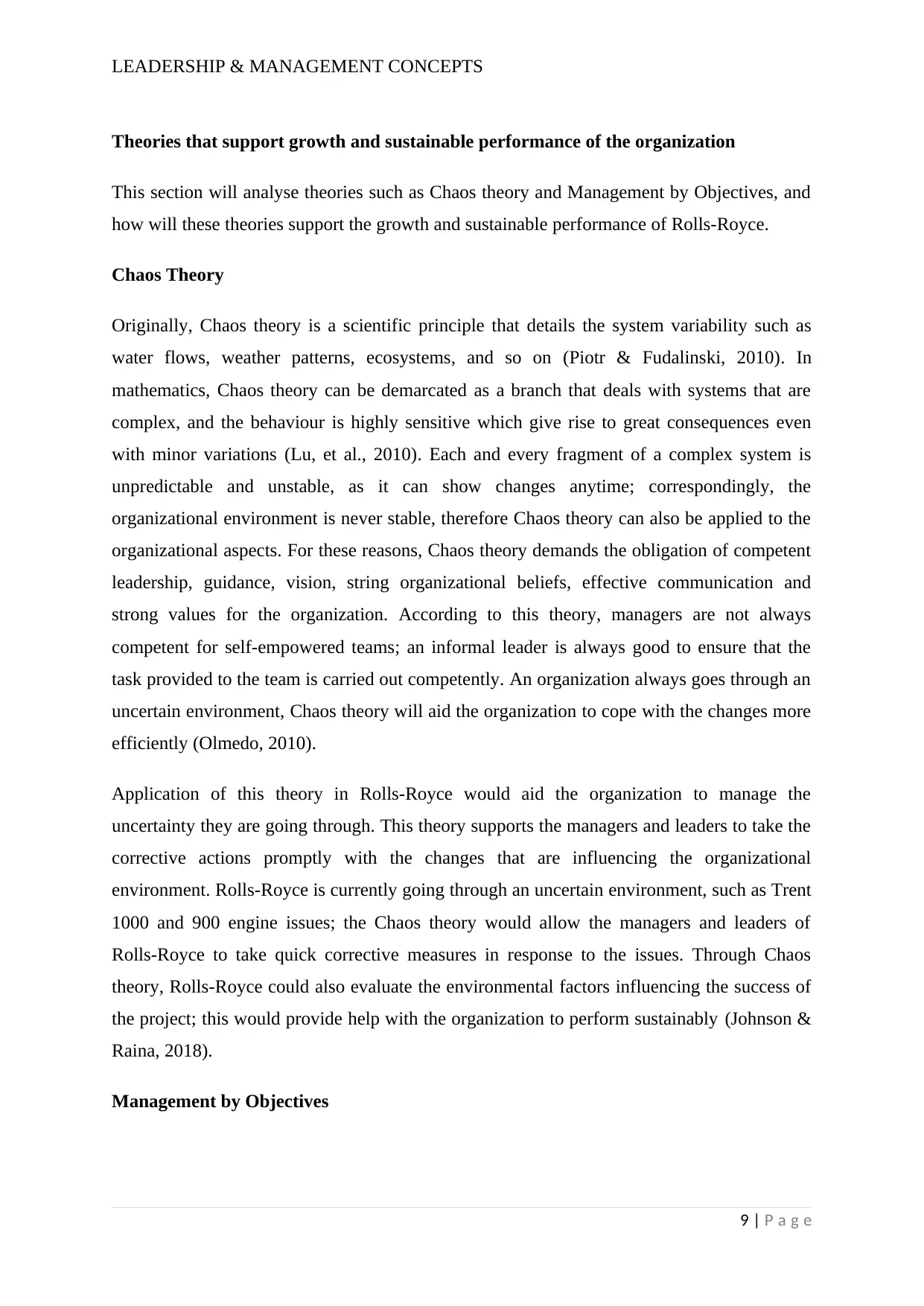
LEADERSHIP & MANAGEMENT CONCEPTS
Theories that support growth and sustainable performance of the organization
This section will analyse theories such as Chaos theory and Management by Objectives, and
how will these theories support the growth and sustainable performance of Rolls-Royce.
Chaos Theory
Originally, Chaos theory is a scientific principle that details the system variability such as
water flows, weather patterns, ecosystems, and so on (Piotr & Fudalinski, 2010). In
mathematics, Chaos theory can be demarcated as a branch that deals with systems that are
complex, and the behaviour is highly sensitive which give rise to great consequences even
with minor variations (Lu, et al., 2010). Each and every fragment of a complex system is
unpredictable and unstable, as it can show changes anytime; correspondingly, the
organizational environment is never stable, therefore Chaos theory can also be applied to the
organizational aspects. For these reasons, Chaos theory demands the obligation of competent
leadership, guidance, vision, string organizational beliefs, effective communication and
strong values for the organization. According to this theory, managers are not always
competent for self-empowered teams; an informal leader is always good to ensure that the
task provided to the team is carried out competently. An organization always goes through an
uncertain environment, Chaos theory will aid the organization to cope with the changes more
efficiently (Olmedo, 2010).
Application of this theory in Rolls-Royce would aid the organization to manage the
uncertainty they are going through. This theory supports the managers and leaders to take the
corrective actions promptly with the changes that are influencing the organizational
environment. Rolls-Royce is currently going through an uncertain environment, such as Trent
1000 and 900 engine issues; the Chaos theory would allow the managers and leaders of
Rolls-Royce to take quick corrective measures in response to the issues. Through Chaos
theory, Rolls-Royce could also evaluate the environmental factors influencing the success of
the project; this would provide help with the organization to perform sustainably (Johnson &
Raina, 2018).
Management by Objectives
9 | P a g e
Theories that support growth and sustainable performance of the organization
This section will analyse theories such as Chaos theory and Management by Objectives, and
how will these theories support the growth and sustainable performance of Rolls-Royce.
Chaos Theory
Originally, Chaos theory is a scientific principle that details the system variability such as
water flows, weather patterns, ecosystems, and so on (Piotr & Fudalinski, 2010). In
mathematics, Chaos theory can be demarcated as a branch that deals with systems that are
complex, and the behaviour is highly sensitive which give rise to great consequences even
with minor variations (Lu, et al., 2010). Each and every fragment of a complex system is
unpredictable and unstable, as it can show changes anytime; correspondingly, the
organizational environment is never stable, therefore Chaos theory can also be applied to the
organizational aspects. For these reasons, Chaos theory demands the obligation of competent
leadership, guidance, vision, string organizational beliefs, effective communication and
strong values for the organization. According to this theory, managers are not always
competent for self-empowered teams; an informal leader is always good to ensure that the
task provided to the team is carried out competently. An organization always goes through an
uncertain environment, Chaos theory will aid the organization to cope with the changes more
efficiently (Olmedo, 2010).
Application of this theory in Rolls-Royce would aid the organization to manage the
uncertainty they are going through. This theory supports the managers and leaders to take the
corrective actions promptly with the changes that are influencing the organizational
environment. Rolls-Royce is currently going through an uncertain environment, such as Trent
1000 and 900 engine issues; the Chaos theory would allow the managers and leaders of
Rolls-Royce to take quick corrective measures in response to the issues. Through Chaos
theory, Rolls-Royce could also evaluate the environmental factors influencing the success of
the project; this would provide help with the organization to perform sustainably (Johnson &
Raina, 2018).
Management by Objectives
9 | P a g e
Paraphrase This Document
Need a fresh take? Get an instant paraphrase of this document with our AI Paraphraser

LEADERSHIP & MANAGEMENT CONCEPTS
MBO is a performance management methodology which entails a sense of balance between
employees as well as the organization’s objectives. The prime intent of using this approach is
to provide feedback in accordance with the joint objectives which were determined between
the organization and the employees (Drucker, 2012). The objectives must be challenging but
realistic; this would empower the employees to work hard to achieve the common goalmouth
(Mio, et al., 2015) If commitment among the employees is increased, managers will get the
prospect to emphasis on new ideas and modernization that would subsidize to the
organizational development. Following are the conditions that should be met according to
this theory.
Formulation of the objectives must be done at qualitative as well as quantitative levels.
Objectives are determined conjointly with the employees
Objectives are encouraging as well as challenging
Daily feedback and coachings (Islami, et al., 2018)
Application of this theory in Rolls-Royce would allow the organization to determine or revise
their organizational objectives which would bring better results. With the effective use of this
theory, Rolls-Royce can effectively interpret their organizational objectives to the employees
which would enhance the output. The company could effectively monitor their progress and
provide regular feedback to their managers; through this step, Rolls-Royce could improve
their operations in each and every level. These are some of the factors which support the
growth and sustainability of Rolls-Royce (Ofojebe & Olibie, 2014).
10 | P a g e
MBO is a performance management methodology which entails a sense of balance between
employees as well as the organization’s objectives. The prime intent of using this approach is
to provide feedback in accordance with the joint objectives which were determined between
the organization and the employees (Drucker, 2012). The objectives must be challenging but
realistic; this would empower the employees to work hard to achieve the common goalmouth
(Mio, et al., 2015) If commitment among the employees is increased, managers will get the
prospect to emphasis on new ideas and modernization that would subsidize to the
organizational development. Following are the conditions that should be met according to
this theory.
Formulation of the objectives must be done at qualitative as well as quantitative levels.
Objectives are determined conjointly with the employees
Objectives are encouraging as well as challenging
Daily feedback and coachings (Islami, et al., 2018)
Application of this theory in Rolls-Royce would allow the organization to determine or revise
their organizational objectives which would bring better results. With the effective use of this
theory, Rolls-Royce can effectively interpret their organizational objectives to the employees
which would enhance the output. The company could effectively monitor their progress and
provide regular feedback to their managers; through this step, Rolls-Royce could improve
their operations in each and every level. These are some of the factors which support the
growth and sustainability of Rolls-Royce (Ofojebe & Olibie, 2014).
10 | P a g e
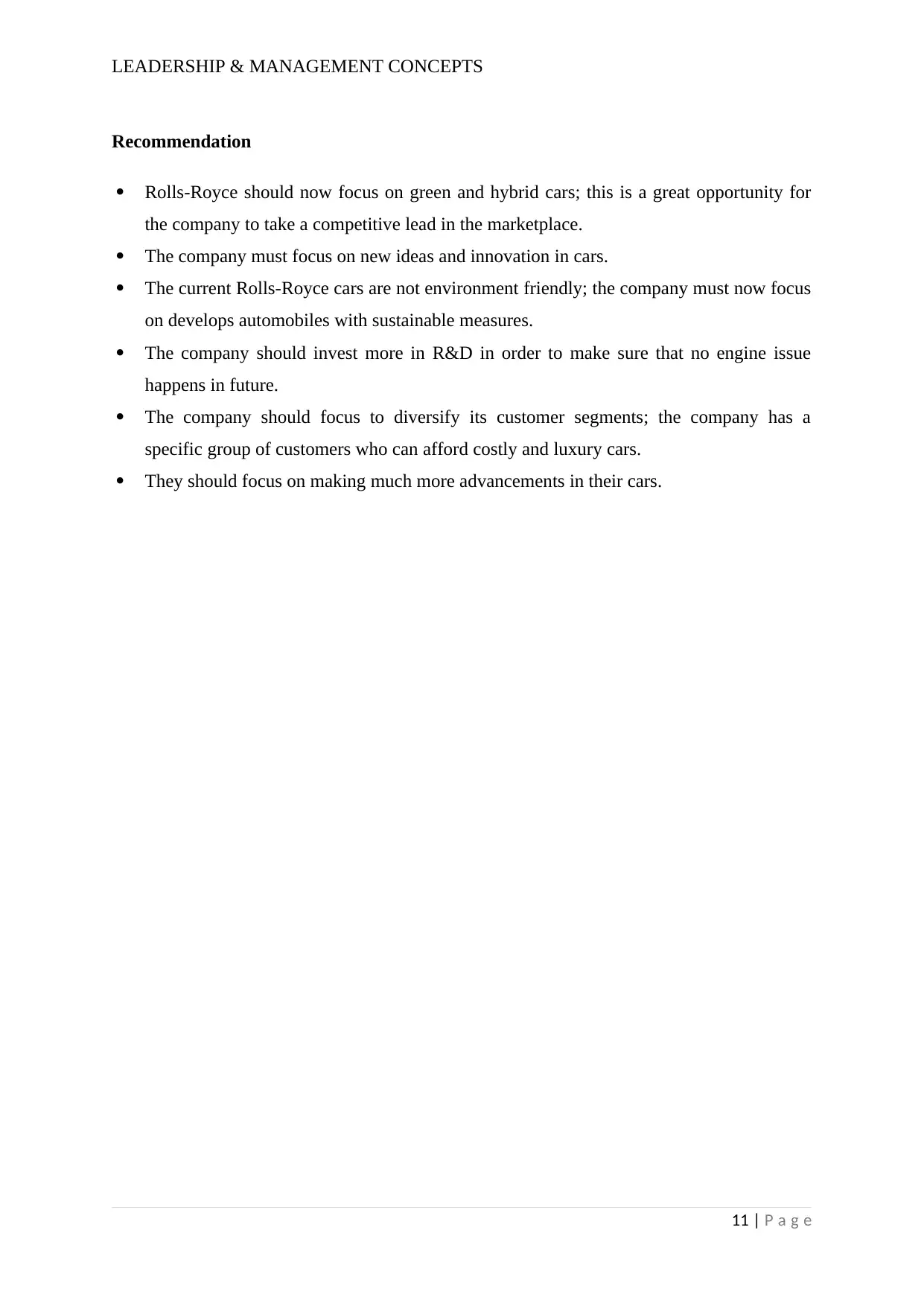
LEADERSHIP & MANAGEMENT CONCEPTS
Recommendation
Rolls-Royce should now focus on green and hybrid cars; this is a great opportunity for
the company to take a competitive lead in the marketplace.
The company must focus on new ideas and innovation in cars.
The current Rolls-Royce cars are not environment friendly; the company must now focus
on develops automobiles with sustainable measures.
The company should invest more in R&D in order to make sure that no engine issue
happens in future.
The company should focus to diversify its customer segments; the company has a
specific group of customers who can afford costly and luxury cars.
They should focus on making much more advancements in their cars.
11 | P a g e
Recommendation
Rolls-Royce should now focus on green and hybrid cars; this is a great opportunity for
the company to take a competitive lead in the marketplace.
The company must focus on new ideas and innovation in cars.
The current Rolls-Royce cars are not environment friendly; the company must now focus
on develops automobiles with sustainable measures.
The company should invest more in R&D in order to make sure that no engine issue
happens in future.
The company should focus to diversify its customer segments; the company has a
specific group of customers who can afford costly and luxury cars.
They should focus on making much more advancements in their cars.
11 | P a g e
⊘ This is a preview!⊘
Do you want full access?
Subscribe today to unlock all pages.

Trusted by 1+ million students worldwide
1 out of 16
Related Documents
Your All-in-One AI-Powered Toolkit for Academic Success.
+13062052269
info@desklib.com
Available 24*7 on WhatsApp / Email
![[object Object]](/_next/static/media/star-bottom.7253800d.svg)
Unlock your academic potential
Copyright © 2020–2025 A2Z Services. All Rights Reserved. Developed and managed by ZUCOL.





